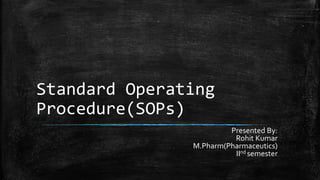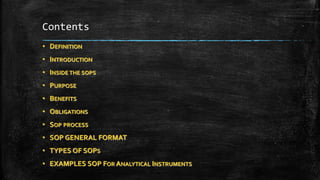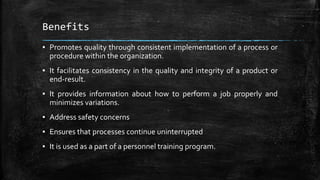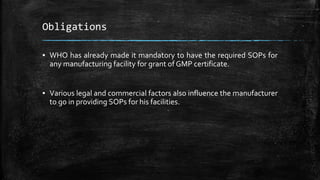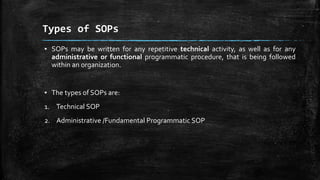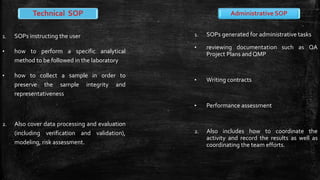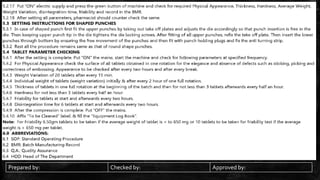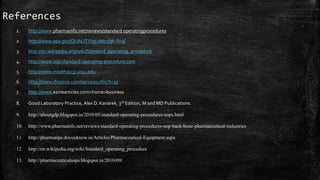Standard operating procedure(so ps)
- 1. Standard Operating Procedure(SOPs) Presented By: Rohit Kumar M.Pharm(Pharmaceutics) IInd semester
- 2. Contents • DEFINITION • INTRODUCTION • INSIDE THE SOPS • PURPOSE • BENEFITS • OBLIGATIONS • SOP PROCESS • SOP GENERAL FORMAT • TYPES OF SOPS • EXAMPLES SOP FOR ANALYTICAL INSTRUMENTS
- 3. Definition ▪ A Standard Operating Procedure (SOP) is a set of written instructions that document a routine or repetitive activity followed by an organization. ▪ ICH defines SOP as “detailed written instructions to achieve uniformity of the performance of a specific function”.
- 4. Introduction ▪ The development and use of SOPs are an integral part of a successful quality system as it provides individuals with the information to perform a job properly, and facilitates consistency in the quality and integrity of a product or end-result. ▪ The term “SOP” may not always be appropriate and terms such as protocols, instructions, worksheets, and laboratory operating procedures may also be used. For this document “SOP” will be used. ▪ SOPs describe both technical and fundamental programmatic operational elements of an organization.
- 5. Inside the SOPs Company name and pagination. The company name and pagination (e.g. page 4 of 7) must appear on every page. Title The title should be descriptive.The title should use directive language to declare what is being done to what. Identification Procedures must be easily identified by giving unique number and version number. This identification number of the SOP supports accountability of the document throughout the facility and over time as it changes.
- 6. Contd……… Review and approval All SOPs shall have space for signature of initiator (the person who has written the SOP) Reviewer (The persons who has reviewed the SOP) and approver (Quality Assurance Head of the organization). Purpose The purpose or objective of the procedure should restate and expand well written title. Expand or qualify the directive language used in the title (e.g. to describe the operation procedure of compression machine) .
- 7. Scope The scope should provide limits to the use of procedure. The scope shall be written in such a way that it answers following questions…. Are there certain samples that are appropriate to test by this method? Do these operations apply only to certain equipment or certain departments? Is there a limit to the capacity, volume, or throughput of the procedure? State to what areas this procedure does apply and does not apply? Responsibility Who is responsible for performing the work described? Who is responsible for implementing the procedure? Procedure Describe the procedure in a step by step, chronological manner. Use active verbs and direct statements
- 8. Purpose ▪ SOPs detail the regularly recurring work processes that are to be conducted or followed within an organization. ▪ They document the way activities are to be performed to facilitate consistent conformance to technical and quality system requirements and to support data quality. ▪ SOPs are intended to be specific to the organization or facility whose activities are described and assist that organization to maintain their quality control and quality assurance processes and ensure compliance with governmental regulations
- 9. If not written correctly, SOPs are of limited value. In addition, the best written SOPs will fail if they are not followed. Therefore, the use of SOPs needs to be reviewed and re-enforced by management, preferably the direct supervisor. Current copies of the SOPs also need to be readily accessible for reference in the work areas of those individuals actually performing the activity, either in hard copy or electronic format. SOPs are tools to ensure that GMP are followed wherever applicable.
- 10. Benefits ▪ Promotes quality through consistent implementation of a process or procedure within the organization. ▪ It facilitates consistency in the quality and integrity of a product or end-result. ▪ It provides information about how to perform a job properly and minimizes variations. ▪ Address safety concerns ▪ Ensures that processes continue uninterrupted ▪ It is used as a part of a personnel training program.
- 11. SOPs assist to ensure that GMP is followed and achieved at all times. SOPs assist the pharmacy personnel to know who does what, and when, thus avoiding confusion, and function overlapping.This also takes care of accountability and responsibility. SOPs help to assure the quality and consistency of the service, and thus minimize harm to the patient. SOPs give clarity to the pharmacy personnel, to follow steps/procedures, systematically, and uniformly.
- 12. Obligations ▪ WHO has already made it mandatory to have the required SOPs for any manufacturing facility for grant of GMP certificate. ▪ Various legal and commercial factors also influence the manufacturer to go in providing SOPs for his facilities.
- 13. SOP PROCESS 1. SOP Preparation 2. SOP Review and Approval 3. Frequency of Revisions and Reviews 4. Implementing SOP 5. Management of SOP
- 14. SOP Preparation: SOPs should be written by individuals knowledgeable with the activity. These individuals are essentially subject-matter experts who actually perform the work or use the process A team approach can be followed, especially for multi-tasked processes
- 15. SOPs should be written with sufficient detail so that someone with limited experience with or knowledge of the procedure, but with a basic understanding, can successfully reproduce the procedure when unsupervised The experience requirement for performing an activity should be noted in the section on personnel qualifications
- 16. SOP Review and Approval SOPs should be reviewed by one or more individuals with appropriate training and experience with the process. The finalized SOPs should be approved as described in the organization’s Quality Management Plan or its Master SOP. Generally the immediate supervisor and the organization’s quality assurance officer review and approve each SOP. Signature approval indicates that an SOP has been both reviewed and approved by management.
- 17. Revisions and Reviews Whenever procedures are changed, SOPs should be updated and re- approved. If desired, modify only the pertinent section of an SOP and indicate the change date/revision number for that section in theTable of Contents. SOPs should be also systematically reviewed on a periodic basis, e.g. every 1-2 years, to ensure that the procedures remain current and appropriate .
- 18. Review date should be added to each SOP that has been reviewed. If an SOP describes a process that is no longer followed, it should be withdrawn from the current file and archived. The frequency of review should be indicated by management in the organization’s Quality Management Plan. Individuals responsible for ensuring that SOPs are current should also be indicated in QMP.
- 19. Implementing SOP The most important step for implementing the SOP is in working area, train or retrain the user. Everyone should follow the procedure exactly with each and every step in detail, it is very important to train the user otherwise individual may interpret meaning in different ways. While training the user trainer should share the reason WHY, SOP must performed correctly. People are much more to follow when they understand importance of procedure. Trainer should explain and demonstrate how each step in the SOP will be performed and should assure them this will increase Quality of product by providing safety and accuracy which will ultimately increase the confidence of the user.
- 20. Management of SOP Organization shall have SOP on Preparation, approval, revision and control of standard Operating Procedure for better control and management of SOPs. Generally, administrative aspects of the SOP system such as distribution and filing are well managed. On the other hand, overall system management, frequently characterized by the lack of a system owner, is generally poor. If a system owner exists at all, his or her responsibilities are limited.
- 21. Name of facility_____________________________________ page .......... of.... SOP Number ________ Title _________________________________________________ Revision number ________ Written by ______________________________ Edited by __________________________ Authorization signature ________________________ Department _______ Date___________ Effective date __________________________________Replaces ____________________ Purpose: WHY: Why is this procedure written. Why is it being performed. Scope WHEN: Indicate when this procedure needs to be performed. WHERE: Indicate where this procedure applies. Responsibility WHO: Who performs the procedure, who is responsible to see it is performed correctly. Materials and equipment WHAT: What is needed to perform the test.The list should be completely specific.
- 22. Types of SOPs ▪ SOPs may be written for any repetitive technical activity, as well as for any administrative or functional programmatic procedure, that is being followed within an organization. ▪ The types of SOPs are: 1. Technical SOP 2. Administrative /Fundamental Programmatic SOP
- 23. 1. SOPs instructing the user • how to perform a specific analytical method to be followed in the laboratory • how to collect a sample in order to preserve the sample integrity and representativeness 2. Also cover data processing and evaluation (including verification and validation), modeling, risk assessment. 1. SOPs generated for administrative tasks • reviewing documentation such as QA Project Plans and QMP • Writing contracts • Performance assessment 2. Also includes how to coordinate the activity and record the results as well as coordinating the team efforts. Technical SOP Administrative SOP
- 24. SOP for analytical instruments:
- 25. Prepared by: Checked by: Approved by:
- 26. References 1. http://www.pharmainfo.net/reviews/standard operatingprocedures 2. http://www.epa.gov/QUALITY/qs-docs/g6-final 3. http://en.wikipedia.org/wiki/Standard_operating_procedure 4. http://www.sop-standard-operating-procedure.com 5. http://www.meathaccp.wisc.edu. 6. http://www.rfnozick.com/services.cfm?t=15 7. http://www.ezinearticles.com>home>business 8. Good Laboratory Practice, Alex D. Kanarek, 3rd Edition, M and MD Publications. 9. http://aboutgdp.blogspot.in/2010/05/standard-operating-procedures-sops.html 10. http://www.pharmainfo.net/reviews/standard-operating-procedures-sop-back-bone-pharmaceutical-industries 11. http://pharmatips.doyouknow.in/Articles/Pharmaceutical-Equipment.aspx 12. http://en.wikipedia.org/wiki/Standard_operating_procedure 13. http://pharmaceuticalsops.blogspot.in/2010/09/
